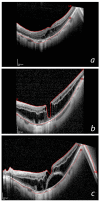Characteristics and Prognostic Factors Associated With the Progression of Myopic Traction Maculopathy in Mexican Patients
- PMID: 38979028
- PMCID: PMC11230611
- DOI: 10.7759/cureus.64036
Characteristics and Prognostic Factors Associated With the Progression of Myopic Traction Maculopathy in Mexican Patients
Abstract
Background In this study, the characteristics and prognostic factors associated with the progression of myopic traction maculopathy (MTM) were evaluated in a Mexican population. Methods This is a retrospective observational study that analyzed patients with MTM who underwent optical coherence tomography (OCT). Clinical-ocular information, the MTM classification, and initial and final visual acuity (VA) were recorded. Results In total, 101 eyes of 84 patients (mean age 63.5 ± 10.7 years) were included (88.1% female and 11.9% male). The mean spherical equivalent was -16.8 ± 6.4 D, axial length was 29.6 ± 2.1 mm, and mean initial VA was 0.8 ± 0.5 logMAR. The mean follow-up time was 25.7 ± 27.6 months. The change in final VA from diagnosis to the last follow-up was +0.1 (0.2) (p = 0.001). Overall, 24.8% of patients progressed, 72.3% did not progress, and 3% showed regression. The patient-year progression rate was 0.20 ± 0.44. Factors associated with progression were initial logMAR VA (p= 0.012) and staphyloma (p= 0.001). Conclusions One in four patients with MTM progressed, and the patient-year progression rate was 0.5. The factors associated with disease progression were initial VA and the presence of staphyloma. The characteristics of Mexican patients with MTM are similar to those described in other populations.
Keywords: high myopia; myopia progression; myopic traction maculopathy; optical coherence tomography; visual acuity.
Copyright © 2024, Bayram-Suverza et al.
Conflict of interest statement
Human subjects: Consent was obtained or waived by all participants in this study. Local Ethics Committee of the “Fundación Hospital Nuestra Señora de la Luz” issued approval 2023R21B2. This study adhered to the guidelines of the Helsinki Declaration and had the approval of the local Ethics Committee of the hospital “Fundación Hospital Nuestra Señora de la Luz” and the Institutional Review Board. Approval code: 2023R21B2. All patients signed written informed consent for participation. Animal subjects: All authors have confirmed that this study did not involve animal subjects or tissue. Conflicts of interest: In compliance with the ICMJE uniform disclosure form, all authors declare the following: Payment/services info: All authors have declared that no financial support was received from any organization for the submitted work. Financial relationships: All authors have declared that they have no financial relationships at present or within the previous three years with any organizations that might have an interest in the submitted work. Other relationships: All authors have declared that there are no other relationships or activities that could appear to have influenced the submitted work.
Figures




References
-
- The epidemics of myopia: aetiology and prevention. Morgan IG, French AN, Ashby RS, Guo X, Ding X, He M, Rose KA. Prog Retin Eye Res. 2018;62:134–149. - PubMed
-
- Global prevalence of myopia and high myopia and temporal trends from 2000 through 2050. Holden BA, Fricke TR, Wilson DA, et al. Ophthalmology. 2016;123:1036–1042. - PubMed
-
- Causes of low vision and blindness in adult Latinos: the Los Angeles Latino Eye Study. Cotter SA, Varma R, Ying-Lai M, Azen SP, Klein R. Ophthalmology. 2006;113:1574–1582. - PubMed
-
- Battaglia Parodi M, Rabiolo A. Encyclopedia of Ophthalmology. Berlin, Heidelberg: Springer; 2018. Pathologic myopia.
LinkOut - more resources
Full Text Sources
